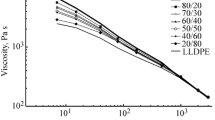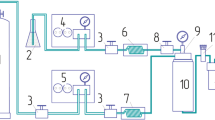Abstract
The influence of the molecular architecture of linear low-density polyethylene on melt miscibility with low-density polyethylene was investigated. Different LLDPE resins with variable type and content of branches were blended at a given composition with the same LDPE. The rheology and different data-treatment methods based on mixture models suggest that the melt blend morphology is strongly dependent on the molecular architecture of the matrix, particularly on the amount of short chain branches. The properties of the blends in which the LLDPE sample possesses a high content of branches can be predicted by the miscible blend additivity rule. The blends in which the LLDPE had the lowest branch content were completely immiscible. In these cases the rheological properties showed values that are higher than expected for miscible blends, as predicted by the Palierne model. The molar mass and the type of comomomer in LLDPE do not play an important role in the melt morphology of the blends at the composition studied. Thus the level of branching in LLDPE is revealed as the molecular feature with the strongest influence on melt miscibility with LDPE.











Similar content being viewed by others
References
Gahleitner M (2011) Editorial corner—a personal view polyolefins for the 21st century. eXPRESS Polym Lett 5:936–936
Martínez-Salazar J, Sánchez-Cuesta M, Plans J (1991) On phase separation in high- and low-density polyethylene blends: 1. Melting-point depression analysis. Polymer 32:2984–2988
Plans J, Sánchez-Cuesta M, Martínez-Salazar J (1991) On phase separation in high- and low- density polyethylene blends: 2. A working model. Polymer 32:2989–2991
Munaro M, Akcelrud L (2008) Correlations between composition and crystallinity of LDPE/HDPE blends. J Polym Res 15:83–88
Lee HS, Denn MM (2000) Blends of linear and branched polyethylenes. Polym Eng Sci 40:1132–1142
Mohammadi M, Yousefi AA, Ehsani M (2012) Thermorheological analysis of blend of high- and low-density polyethylenes. J Polym Res 19:9798–9810
Ho K, Kale L, Montgomery S (2002) Melt strength of linear low-density polyethylene/low-density polyethylene blends. J Appl Polym Sci 85:1408–1418
Delgadillo-Velázquez O, Hatzikiriakos SG, Sentmanat M (2008) Thermorheological properties of LLDPE/LDPE blends: Effects of production technology of LLDPE. J Polym Sci: Part B: Polym Phys 46:1669–1683
Hussein IA, Hameed T, Sharkh BFA, Khaled M (2003) Miscibility of hexene-LLDPE and LDPE blends: influence of branch content and composition distribution. Polymer 44:4665–4672
Hussein IA, Williams MC (2004) Rheological study of the influence of branch content on the miscibility of octene m-LLDPE and ZN-LLDPE in LDPE. Polym Eng Sci 44:660–672
Hussein IA, Williams MC (2004) Rheological study of heterogeneities in melt blends of ZN-LLDPE and LDPE: Influence of Mw and comonomer type, and implications for miscibility. Rheol Acta 43:602–614
Fang Y, Carreau PJ, Lafleur PG (2005) Thermal and rheological properties of mLLDPE/LDPE blends. Polym Eng Sci 45:1254–1269
Shin TJ, Lee B, Lee J, Jin S, Sung BS, Han YS, Lee C-H, Stein RS, Ree M (2009) Small-angle neutron scattering study of the miscibility of metallocene-catalyzed octene linear low-density polyethylene and low-density polyethylene blends. J Appl Crystal 42:161–168
Shin TJ, Lee B, Seong BS, Han YS, Lee C-H, Song HH, Stein RS, Ree M (2010) Composition-dependent phase segregation and cocrystallization behaviors of blends of metallocene-catalyzed octene-LLDPE(D) and LDPE(H). Polymer 51:5799–5806
Zhao L, Choi P (2006) A review of the miscibility of polyethylene blends. Mater Manuf Procces 2:135–142
Wagner MH, Kheirandish S, Yamaguchi M (2004) Quantitative analysis of melt elongation behaviour of LDPE/LLDPE blends. Rheol Acta 44:198–218
Puig CC (2001) Enhanced crystallisation in branched polyethylenes when blended with linear polyethylene. Polymer 42:6579–6585
Robledo N, Vega JF, Nieto J, Martínez-Salazar J (2009) The role of the interface in melt linear viscoelastic properties of LLDPE/LDPE blends: effect of the molecular architecture of the matrix. J Appl Polym Sci 114:420–429
Robledo N, Vega JF, Nieto J, Martínez-Salazar J (2011) Role of the interface in melt linear viscoelastic properties of LLDPE/LDPE blends: effect of the molecular architecture of the dispersed phase. J Appl Polym Sci 119:3217–3226
Liu C, Wang J, He J (2002) Rheological and thermal properties of m-LLDPE blends with m-HDPE and LDPE. Polymer 43:3811–3818
Hameed T, Hussein IA (2004) Effect of short chain branching of LDPE on its miscibility with linear HDPE. Macromol Mater Eng 289:198–203
Gramespacher H, Meissner (1992) Interfacial tension between polymer melts measured by shear oscillations of their blends. J Rheol 36:1127–1141
Lacroix C, Aressy M, Carreau P (1997) Linear viscoelastic behavior of molten polymer blends: a comparative study of the Palierne and Lee and Park models. Rheol Acta 36:416–428
Mavridis H, Shroff RN (1992) Temperature dependence of polyolefin melt rheology. Polym Eng Sci 32:1778–1791
Keßner U, Münstedt H (2010) Thermorheology as a method to analyze long-chain branched polyethylenes. Polymer 51:507–513
Kessner U, Kaschta J, Stadler FJ, Le Duff CS, Drooghaag X, Münstedt H (2010) Thermorheological behavior of various short- and long-chain branched polyethylenes and their correlations with the molecular structure. Macromolecules 43:7341–7350
Vega JF, Ramos J, Martínez-Salazar J (2014) Effect of short chain branching in molecular dimensions and Newtonian viscosity of ethylene/1-hexene copolymers: matching atomistic simulations to conformational and rheological experimental properties. Rheol Acta 53:1–13
Arnett RL, Thomas CP (1980) Zero-shear viscosity of some ethyl branched paraffinic model polymers. J Phys Chem 6:649–652
Vega JF, Santamaría A, Muñoz-Escalona A, Lafuente P (1998) Small-amplitude oscillatory shear flow measurements as a tool to detect very low amounts of long chain branching in polyethylenes. Macromolecules 31:3639–3647
Stadler FJ, Gabriel C, Münstedt H (2007) Influence of short-chain branching of polyethylenes on the temperature dependence of rheological properties in shear. Macromol Chem Phys 208:2449–2454
Lobón-Poo M, Osío-Barcina J, García-Martínez A, Expósito MT, Vega JF, Martínez-Salazar J, López M (2006) Meso-[norbornane-7,7-bis(indenyl)]titanium dichloride: a highly active catalyst for ethylene-styrene copolymerization. Macromolecules 39:7479–7482
Vega JF, Expósito MT, Martínez-Salazar J, Lobón-Poo M, Osío-Barcina J, García-Martínez (2011) Molecular architecture and linear viscoelasticity of homogeneous ethylene/styrene copolymers. Rheol Acta 50:207–220
Labaig JJ, Monge P, Bednarik J (1973) Steady flow and dynamic viscoelastic properties of branched polyethylene. Polymer 1:384–386
Trinkle S, Friedrich C (2001) Van Gurp–Palmen plot: a way to characterize polydispersity of linear polymers. Rheol Acta 40:322–328
Trinkle S, Walter P, Friedrich C (2002) Van Gurp–Palmen Plot II—classification of long chain branched polymers by their topology. Rheol Acta 41:103–113
Delgadillo-Velázquez O, Hatzikiriakos SG, Sentmanat M (2008) Thermorheological properties of LLDPE/LDPE blends. Rheol Acta 47:19–31
Groves DJ, McLeish TCB, Chohan RK, Koates PD (1996) Predicting the rheology of linear with branched polyethylene blends. Rheol Acta 35:481–493
Bird RB, Armstrong RC, Hassager O (1987) Dynamics of Polymeric Liquids, 1, 2nd edn. Wiley Interscience, New York
Palierne JF (1990) Linear rheology of viscoelastic emulsions with interfacial tension. Rheol Acta 29:204–214
Peón J, Aguilar M, Vega JF, del Amo B, Martínez-Salazar J (2003) On the processability of metallocene-catalysed polyethylene: effects of blending with ethylene–vinyl acetate copolymer. Polymer 44:1589–1594
Peón J, Vega JF, Aroca M, Martínez-Salazar J (2006) Rheological behaviour of LDPE/EVAc blends. II. Linear viscoelasticity and extrusion properties. J Mater Sci 41:4814–4822
Chen YY, Lodge TP, Bates FS (2002) Influence of long-chain branching on the miscibility of poly(ethylene-r-ethylethylene) blends with different microstructures. J Polym Sci: Part B: Polym Phys 40:466–477
Acknowledgments
The authors acknowledge funding support from Dow Chemical Ibérica, S.L. and from the Ministerio de Economía y Competitividad – MINECO (Spain) - Project MAT2012-36341.
Author information
Authors and Affiliations
Corresponding author
Rights and permissions
About this article
Cite this article
Vicente-Alique, E., Vega, J.F., Robledo, N. et al. Study of the effect of the molecular architecture of the components on the melt rheological properties of polyethylene blends. J Polym Res 22, 62 (2015). https://doi.org/10.1007/s10965-015-0705-7
Received:
Accepted:
Published:
DOI: https://doi.org/10.1007/s10965-015-0705-7




